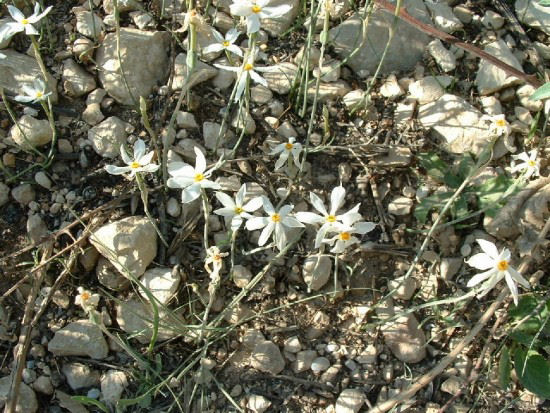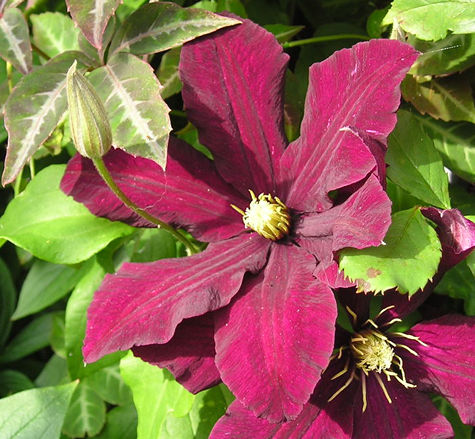Well, I know I am trying to recreate the Himalayas but this Indian summer we're experiencing this October is playing havoc up on the roof with spring bulbs poking up when they shouldn't be and seeds that supposedly need a winter chill to stratify them (ie break their dormancy so they can germinate in more clement weather, not the middle of winter) germinating all over the place.
 |
| Iris "Eye of the Tiger taken a few days ago. They're at least twice that height now. Oh dear... |
Among the culprits are Irises reticulata (Jan/Feb) and "Bronze Beauty", which is in the xiphium group and due to flower in May, but is pushing on up. You might think I'm at fault for planting them too shallow but on this occassion, unlike with "Eye of the tiger" (now a good 6-8in tall), I have followed the general rule of three and a half times the height of the bulb.
 |
| Iris reticulata: only three or four months early |
 |
| A dreadful photo (built-in flash) of Bronze Beauty popping up (that's it right in the centre of the shot) |
 |
| Crocus sativus (where saffron comes from) is an autumn bloomer. Well done, good Crocus! |
Meconopsis betonicifolia and regia have both begun to germinate, which is a bit worrying as the nights draw in. I just hope they have the legs to make it through the winter. If not, I'll just start again but the general rule for the genus is a period of warmth, a period of cold (winter) and another period of warmth to get them going. They've just missed out the winter bit. Ho hum.
 |
| Look, it's dawn outside, I need the rubbish flash! That's a Mecanopsis regia seedling in the centre,. It's taken two weeks to germinate! |
Undeterred I sowed a load of stuff yesterday: Penstemons confertus and cyanothus (both slightly ugly things but unusual enough to make the cut; Primula x bullesiana (a rainbow of candelabras); Iris attica (5 seeds! which varies from yellow through to purple; Meconopsis integrifolia (a yellow-flowering monster of the same type as M. regia with huge, furry rossettes and death following flowering); the gorgeous Gladiolus tristis with white/cream flowers; Narcissus serotinus (a tiny, gentile thing with grass-like foliage and delicate white blooms with tiny orange trumpets); and some Lewisia cotyledon hybrids because they are so easy and will thrive up here, providing splashes of colour wherever I need it.
 |
| Narcissus Serotinus in its native Mediterranian habitat |
Remember my Clematis tower? Well, the plants arrived from the brilliant Thorncroft Clematis at a height of no more than a foot (but with beautiful, healthy roots). I have four in there: "Nelly Moser", "Niobe", tibetana "Orange Peel" and "Jacqueline du Pré", the idea being that I should have at least one in flower all year round. It looks like "Niobe" is going to reach the top first, it's about five feet at the moment, and be first to unfurl it's deep, velvety red flowers.
 |
I'm really pleased with this, as until the Cardiocrinum and Lilies reach maturity it provides the only vertical interest
|
 |
| Nelly, Niobe, Orange Peel and Jacqueline du Pre |
I decided to give the parlour palm a haircut, mainly to stop it blowing over. Whether the palm makes it through the winter or not depends entirely on whether I can keep it dry and how cold it is. It's no loss if it goes, I never planned a tropical theme and it's just a reject from the living room anyway.
My policy of choosing the Cyclamen hederifolium with the fewest open leaves or flowers (it looked a bit like a load of lampreys feeding on a dead whale) has paid off: It looks good now and will look brilliant in perhaps 10 days
Devoted followers (if I have any) will remember I sowed some mixed Pelargonium species seed collected from South Africa and sent to me by my friends at Chiltern seeds. Well, the first two that bolted up went a bit leggy after pricking out (I left them in the rather shady "greenhouse" to acclimatise but I've been hardening them off and the main stems are thickening up nicely. Didn't repeat the mistake with the other three that germinated (there were only 10 seeds so 50% ain't a bad yeild)
 |
| Bit leggy but improving |
 |
Not leggy!
|
Chilterns provided a list of the species they might be so it's a question of waiting until they flower to match up the plants to web images (not always easy with Pelargonium species as they all tend to look a bit white and samey. Anyway, a nice problem to have.
 |
| Lathyrus chloranthus |
Finally today, I've taken the gamble of planting out the acid yellow sweet pea lathyrus chlorathus which I'm using to screen the little greenhouse because I have another five plants should these prove too tender to make it through the winter. It's an annual but hopefully things will work out and I can collect seed because it really is an amazing colour! You can get seed from Suttons, British readers. It hasn't put out any tendrils yet (I deliberately pinched them out to get as many stems as possible) so might need a bit of help up the trellis. And then it might look something like this:
 |
| ©Suttons seeds |



















No comments:
Post a Comment